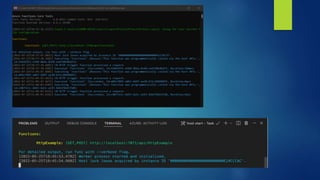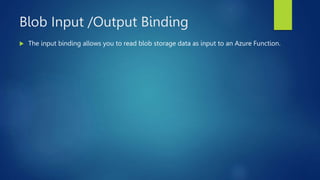Azure Functions.pptx
- 2. What is Azure Functions Azure Functions is a serverless solution that allows you to write less code, maintain less infrastructure, and save on costs. Instead of worrying about deploying and maintaining servers, the cloud infrastructure provides all the up-to- date resources needed to keep your applications running. Functions provides serverless compute for Azure. Azure Functions allows you to run small pieces of code (Called Functions) without about application infrastructure
- 3. Where can we use Azure functions Reminders and notifications Scheduled tasks and messages File processing Data or data streams processing Running background backup tasks Computing backend calculations Lightweight Web APIs and Proof of Concepts, MVPs
- 4. Features of Azure Functions Integration with Other Azure Services :- As part of Microsoft Azure, you can easily incorporate Functions with Azure Event Hubs, Notification Hubs, Service Bus, Event Grids, and more. Supports Different Programming Languages :-Functions support major languages such as Python, Java, JavaScript, C#, F#, PHP, and Node.js. In this way, you can use different programming models for activities like HTTP-based API building. Continuous Integration and Continuous Deployment (CICD) Serverless Applications Pay-per-use pricing model Integrated Security Flexible Development Serverless Applications
- 5. What we can do with Azure Functions Azure Functions is a Great solution for processing bulk data, integrating systems, working with IOT and building simple APIs and micro services. You can run Azure Functions on various events or Triggers. HTTP Request Schedule Timer Document Addition or modification in Azure Cosmos DB etc. Azure Function App :- Will Facility the execution of Azure Functions .We can use Function App to Group Functions as logical unit for easier management, deployment. Azure Functions Topics How to create a Function App project in visual studio. Run the Function locally Publish the project to Azure Test your Function in Azure What is Function .JSON File Understand configuration in function .JSON File
- 6. Application patterns Function Chaining Fan-out/Fan-in Async HTTP APIs Monitoring Human interaction Aggregator (stateful Entities)
- 7. Function Chaining In the function chaining pattern, a sequence of functions executes in a specific order. In this pattern, the output of one function is applied to the input of another function
- 8. Fan-out/Fan-in In the fan out/fan in pattern, you execute multiple functions in parallel and then wait for all functions to finish. Often, some aggregation work is done on the results that are returned from the functions.
- 9. Async HTTP APIs The async HTTP API pattern addresses the problem of coordinating the state of long- running operations with external clients. A common way to implement this pattern is by having an HTTP endpoint trigger the long running action. Then, redirect the client to a status endpoint that the client polls to learn when the operation is finished.
- 10. Monitoring The monitor pattern refers to a flexible, recurring process in a workflow. An example is polling until specific conditions are met. You can use a regular timer trigger to address a basic scenario.
- 11. Human interaction Many automated processes involve some kind of human interaction. Involving humans in an automated process is tricky because people aren’t as highly available and as responsive as cloud services. An automated process might allow for this interaction by using timeouts and compensation logic.
- 12. Aggregator (stateful Entities) The sixth pattern is about aggregating event data over a period of time into a single, address able entity. In this pattern, the data being aggregated may come from multiple sources, may be delivered in batches, or may be scattered over long-periods of time. The aggregator might need to take action on event data as it arrives, and external clients may need to query the aggregated data.
- 13. Compare Azure Functions and Azure Logic Apps Compare Azure Functions and Azure Logic Apps DURABLE FUNCTIONS LOGIC APP S Development Code-first (imperative) Designer-first (declarative) Connectivity About a dozen built-in binding types, write code for custom bindings Large collection of connectors, Enterprise Integration Pack for B2B scenarios, build custom connectors Actions Each activity is an Azure function; write code for activity functions Large collection of ready-made actions Monitoring Azure Application Insights Azure portal, Azure Monitor logs, Microsoft Defender for Cloud Management REST API, Visual Studio Azure portal, REST API, PowerShell, Visual Studio Execution context Can run locally or in the cloud Runs only in the cloud Compare Functions and Web Jobs Web Jobs and the Web Jobs SDK Functions and Logic Apps are Azure services that enable serverless workloads. Azure Functions is a serverless compute service, whereas Azure Logic Apps provides serverless workflows. Both can create complex orchestrations. An orchestration is a collection of functions or steps, called actions in Logic Apps, that are executed to accomplish a complex task.
- 14. Function.Json file For Compiled language function .json file generated automatically from annotation in your code . For scripting languages , you must provide the config file yourself. The Function .json file defines trigger , bindings, and other configuration settings of Azure Functions . Every Function has one and only one trigger. Azure Function runtime will determine what events to monitor and how to pass data into and return data from a Azure Function using this Function .json details. Every Function has one and only one trigger. Azure Functions runtime will determine what events to monitor and how to pass data into and return data from a Azure function using this Function .json file details.
- 15. Azure Functions hosting When you create a function app in Azure , you must choose a hosting plan for your app. There are three basic hosting plans available for Azure Functions. Consumption plan Premium plan Dedicated (App Service) plan The hosting plan you choose dictates the following behaviors: How your function app is scaled. There sources available to each function app instance. Support for advanced functionality, such as Azure Virtual Network connectivity
- 16. Consumption plan When you're using the Consumption plan, instances of the Azure Functions host are dynamically added and removed based on the number of incoming events. The Consumption plan is the fully serverless hosting option for Azure Functions. Consumption plan Benefits Scale automatically and only pay for compute resources when your functions are running. Default hosting plan. Pay only when your functions are running. Scales automatically, even during periods of high load.
- 17. Billing Billing is based on number of executions, execution time, and memory used. Usage is aggregated across all functions within a function app. Create a Consumption plan function app Azure command-line interface (Azure CLI) Azure portal Azure Resource Manager template
- 18. Premium plan The Azure Functions Elastic Premium plan is a dynamic scale hosting option for function apps. For other hosting plan options. Automatically scales based on demand using pre-warmed workers, which run applications with no delay after being idle, runs on more powerful instances, and connects to virtual networks. Premium plan Benefits Avoid cold starts with perpetually warm instances Virtual network connectivity. Unlimited execution duration, with 60 minutes guaranteed. Premium instance sizes: one core, two core, and four core instances. More predictable pricing, compared with the Consumption plan. High-density app allocation for plans with multiple function apps.
- 19. Dedicated hosting Run your functions just like your web apps. If you use App Service for your other applications, your functions can on the same plan at no additional cost. You have existing, underutilized VMs that are already running other App Service instances. Predictive scaling and costs are required.
- 20. App Service Environment App Service Environment (ASE) is an App Service feature that provides a fully isolated and dedicated environment for securely running App Service apps at high scale. ASEs are appropriate for application workloads that require: Very high scale. Full compute isolation and secure network access. High memory us
- 21. Kubernetes Kubernetes provides a fully isolated and dedicated environment running on top of the Kubernetes platform. Kubernetes is appropriate for application workloads that require: Custom hardware requirements. Isolation and secure network access. Ability to run in hybrid or multi-cloud environment. Run along side existing Kubernetes applications and services.
- 22. Function app timeout duration The time out duration of a function app is defined by the function Timeout property in the host. json project file.
- 23. Create a C# function in Azure using Visual Studio Code CCocal project
- 25. Create a Java function in Azure using Visual Studio Code Development tool Gradle, IntelliJ IDEA Maven
- 26. Create a JavaScript function in Azure using Visual Studio Code
- 27. Create a function in Azure with Python using Visual Studio Code
- 28. Create your first C# function in Azure using Visual Studio
- 31. Publish the project to Azure
- 34. Connect Azure Functions to Azure Storage using Visual Studio Code Ex.
- 37. Async :- The async keyword turns a method into an async method, which allows you to use the await keyword in its body. When the await keyword is applied, it suspends the calling method and yields control back to its caller until the awaited task is complete. await can only be used inside an async method.
- 38. Binding Expression Patterns One of the Most powerful features of triggers and bindings is binding expressions. We can use these Bindings Expressions in Function .json file or in Trigger and Binding Attributes These Expressions will resolve to values when you execute your function. Most of times, binding Expression are identified by wrapping them in curly braces. Types of Binding Expressions App Settings Trigger File Name Trigger Meta Data
- 39. Azure Blob storage trigger for Azure Functions Blob Storage Bindings :- Azure Functions integrated with Azure Storage via Triggers and Bindings. Integration with Blob storage helps to build Azure functions with which will react to changes in Blob storage and read data from Blob storage and write Data to Blob storage
- 40. Blob Input /Output Binding The input binding allows you to read blob storage data as input to an Azure Function.
- 41. Thank You
- 42. To know more follow azure documents









































